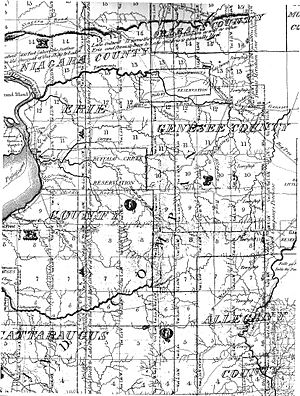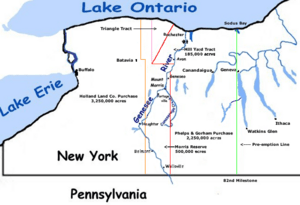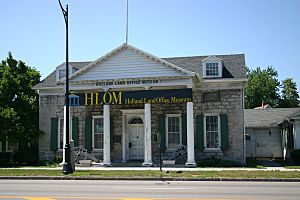Holland Land Company facts for kids
The Holland Land Company was a group of thirteen Dutch investors from Amsterdam. In 1792 and 1793, they bought a huge area of land in what is now western New York State. This land became known as the Holland Purchase.
At that time, people from other countries usually couldn't own land directly in New York. So, these investors put their money with special trustees. These trustees then bought the land for them. The Dutch investors hoped to sell the land quickly and make a lot of money. However, they ended up having to spend more money. They paid for surveying the land, building roads, and digging canals. These improvements made the land more appealing to new settlers. The company sold its last land in 1840, and then the group officially closed down.
Contents
Buying a Huge Piece of Land
The land bought in Western New York was enormous. It was about 3.25 million acres (13,150 square kilometers). This area was part of the Phelps and Gorham Purchase and was located west of the Genesee River. The Holland Land Company bought it in stages during 1792 and 1793. They bought it from Robert Morris.
Robert Morris was a very important person. He had signed the Declaration of Independence and helped pay for the American Revolution. At the time, he was one of the richest people in America. Morris had bought this land from Massachusetts in 1791. This happened after Phelps and Gorham, the original buyers, couldn't get the Native American agreement to sell the land and also failed to make their payments.
Morris bought all the land west of the Genesee River. However, he did not buy the 185,000 acres (750 km2) Mill Yard Tract. Phelps and Gorham kept this tract, along with their other lands east of the Genesee River. Morris paid Massachusetts about $333,333 for the land. This was a huge amount of money back then. Morris's purchase was for about 3.75 million acres. But he kept about 500,000 acres (2,000 km2) for himself. This part was a strip 12 miles (19 km) wide. It stretched across Western New York from Lake Ontario down to Pennsylvania. This 500,000 acres (2,000 km2) area was called the Morris Reserve.
The Treaty of Big Tree
Before the Holland Land Company could truly own the land, they needed to get the Native Americans' agreement to sell it. This important step happened at the 1797 Treaty of Big Tree. The treaty was signed near the Genesee River, close to where Geneseo is today. This is south of Rochester.
Representatives from the Holland Land Company, Robert Morris, and the Seneca people met in August 1797. Mary Jemison, a famous negotiator, represented the Seneca. A commissioner for the United States was also there. Important Seneca chiefs like Red Jacket, Cornplanter, and Governor Blacksnake attended. About 50 other chiefs and leaders were also present.
Red Jacket and Cornplanter spoke strongly against selling the land. They wanted to keep certain areas for their people. These areas were called "reservations." After many talks, the Treaty of Big Tree was signed on September 15, 1797. The Seneca people received $100,000 for their rights to about 3.75 million acres. They also kept about 200,000 acres (809 square kilometers) for their own use.
In 1798, the New York Legislature, with help from Aaron Burr, allowed people from other countries to own land directly. So, the trustees officially gave the Holland Purchase to the real owners. The land was divided among three groups of owners. As owners passed away, their share went to the remaining owners.
Managing the Land Company
The members of the Holland Land Company never actually traveled to America. They sent a general agent, Theophile Cazenove, to oversee their land purchases. Cazenove was based in Philadelphia. The company invested in American government funds and shares in canal companies. These canals, like the Patowmack Canal, helped transport goods.
Mapping the Land
In 1798, the company hired Joseph Ellicott. He, along with his brother Benjamin and 130 other men, spent three years surveying the huge land purchase. This detailed mapping cost over $70,000.
Selling the Land
In 1799, Paul Busti became the new General Agent. He was from Italy but had worked in Amsterdam. Other important agents included Gerrit Boon and Adam Gerard Mappa. John Jacob Vanderkemp took over as Agent General after Busti died in 1824. He stayed in this role until the company sold all its properties in the 1840s.
The Holland Land Company opened its main land office in 1801 in Batavia, New York. They chose Batavia because it was the county seat for Genesee County, where much of their land was located. They also had smaller offices in places like Mayville, Ellicottville, Buffalo, and Meadville. Agents were told to keep all records in fireproof safes or banks.
By 1840, all the land in Western New York had been sold to local investors and settlers. Around 1846, all the company's business in the United States was finished, and the company officially closed down.
The town of Holland, New York is named after the Holland Land Company.




